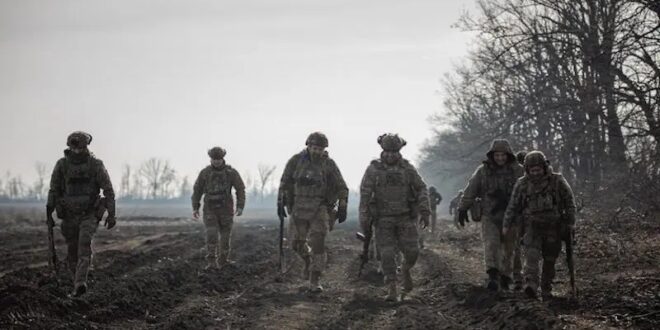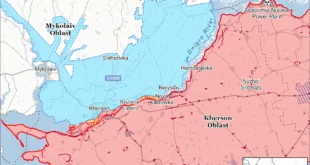Ukrainian civilians evacuated from border regions with Russia. An important east-west highway in the eastern Donetsk region threatened by encroaching Russian forces. A village captured by Ukraine during last year’s counteroffensive about to return to Russian control. Ukraine’s president cancels all foreign trips.
The news from Ukraine’s battlefield these days is grim: Russia is advancing. Ukraine is struggling to hold its positions, if not outright retreating.
Ukrainian forces were already under severe pressure in several locations along the 1,100-kilometer front line even before Russia launched a localized offensive north of Ukraine’s second largest city, Kharkiv, last week. Troops moved into a “gray zone” — Ukrainian territory that’s not fully controlled by either Ukrainian or Russian forces. On May 16, Russian units appeared to have entered the town of Vovchansk, about 5 kilometers from the border, and the site of the fiercest fighting in the north.
By some estimates, the amount of territory Ukrainian troops have ceded in recent months is greater than the earliest months after the full Russian invasion in February 2022.
Western military officials, however, downplay Russian chances for a wider breakthrough.
“They don’t have the skill and the capability to do it, to operate at the scale necessary to exploit any breakthrough to strategic advantage,” U.S. Army General Christopher Cavoli said on May 17. “They do have the ability to make local advances and they have done some of that.”
Still, there’s little doubt that Ukraine’s exhausted, outmanned, and possibly still-outgunned forces are struggling in a way not seen possibly since the opening days of the invasion.
“By stretching Ukrainian forces along a wide front, Russia is overcoming the limitations of its undertrained army,” Jack Watling, a senior research fellow at the Royal United Services Institute, said in a report released this week. “Russia has now started the early phases of its anticipated summer offensive with renewed attacks on Kharkiv.”
Here’s where things stand at present on Ukraine’s battlefield.
What’s Happening On The Ground?
After Ukraine’s much-hyped counteroffensive fizzled late last year both sides began retooling and resupply, girding for the next major clashes. Russia, however, seized the initiative to push into the industrial city of Avdiyivka, where Ukraine was able to threaten the Russian-controlled regional administrative center of Donetsk to the southeast. The city fell to Russian forces in February.
Last month, Russian troops took advantage of a Ukrainian troop rotation — some reports say botched — and pushed northwest of Avdiyivka to take control of the village of Ocheretyne. Creeping north and northwest, Russian forces have moved closer to threatening the N32 highway, which runs from Pokrovsk, northeast to the railway town of Kostyantynivka.
Just east of Kostyantynivka is Chasiv Yar, a village on high ground that Russia is hellbent on capturing.
Ukrainian forces have repelled the effort so far, in part by using a water canal that runs through its eastern district as a holding line. Captain Oleh Kalashnikov, a spokesman for the 26th Separate Mechanized Brigade, told Current Time that Russia had fielded as many as 25,000 troops, including elite paratroop units, in their push to take the city.
Seizing Chasiv Yar would allow Russia to threaten Kostyantynivka and its rail and roadway used by Ukraine to resupply its forces. It would crack the door toward Kramatorsk to the north, and Slovyansk, both large population centers and redoubts of Ukrainian troops and supplies.
On May 10, meanwhile, Russian infantry crossed the border north and northeast of Kharkiv, attacking in two different locations, seizing a handful of small settlements, and opening a new front The village of Vovchansk came under some of the worst shelling, forcing rescuers to rush to evacuate civilians.
Ukraine’s General Staff claimed that its forces pushed back some of the Russians units. However, on May 14, officials said troops were “moving to more advantageous positions” near Vovchansk and Lukyantsi — suggesting some sort of withdrawal, or even retreat.
Two days later, officials announced Ukrainian troops were withdrawing to “more advantageous positions” near Kupyansk, a town east of Kharkiv that has been under pressure from Russia in recent months.
Colonel General Oleksandyr Syrskiy, the country’s top military commander, said the situation had “significantly deteriorated.” “We understand that there will be tough battles ahead and the enemy is preparing for it,” he said on May 17. A further sign of difficulties: President Volodymyr Zelenskiy postponed foreign travels and visited Kharkiv a day earlier. He also dismissed the Ukrainian commander in charge of the Kharkiv front.
Hundreds of kilometers to the southwest, in the Zaporizhzhya region, Russian forces claimed to have retaken Robotyne, one of a handful of villages that Ukraine succeeded in capturing in its counteroffensive — their biggest to date. Ukrainian officials denied the claim, but if the village does fall, its loss would be a symbolic blow.
“It’s a challenging situation on the battlefield right now in Ukraine,” U.S. Major General Pat Ryder, a Pentagon spokesman, said this week.
“The Russians have exploited the situation on the battlefield, and are attempting to make advances,” he said. “Incremental as they may be, it’s certainly concerning.”
Why Is It Happening?
From Ukraine’s side, there are at least two primary reasons why it’s been knocked back on its heels.
First is the monthslong pause in U.S. weaponry that resulted from political deadlock among congressional lawmakers in Washington, D.C. A group of Republican lawmakers blocked a $60 billion package, conditioning its passage on sweeping changes to U.S. immigration and border policies.
Ukraine scrambled to keep firing pace with Russia, then fell behind sharply, as stocks dwindled and Russia leveraged its bigger industrial capacity. Analysts said Russia was outfiring Ukraine 10-to-1 in some locations. Russia also leveraged its use of “glide bombs” — heavy-explosive “dumb” bombs retrofitted with wings and satellite navigation — to devastating effect.
The weapons package finally passed the U.S. Congress on April 23, and the Defense Department quickly announced shipments of air defense missiles, ammunition, and precision artillery systems.
But it will still require time and logistics to get the weaponry to the hands of gunners or infantrymen in trenches and forests.
Just as important an explanation for Ukraine’s struggles is the lack of men. Ukrainian troops are outmanned and exhausted, and casualty rates are soaring. They are for Russia as well, but Russia has a bigger population to draw from, and authorities there have come up with an improvised system of recruiting – using high wages, and lucrative perks – to attract men to the fight.
As many as 510,000 Russians are employed in the overall invasion at present, Watling estimated.
Ukraine has struggled to keep troop levels up, and units rotated and rested. The government dragged its feet in updating its system of mobilization, highlighted by public comments by Syrskiy’s predecessor, General Valeriy Zaluzhniy, in comments to The Economist magazine last fall. Zaluzhniy was ultimately pushed out.
The mobilization reforms were signed into law last month. But as with the weaponry, it will take time to get new troops trained, equipped, and ready to deploy to the front.
Oleksandr Demchenko, a staff sergeant deployed to the Kharkiv region with the 516th Separate Special Purpose Battalion, said the Russian breakthrough along the border forced commanders to redeploy units exhausted after Avdiyivka.
“Instead of rest and recovery, they are again forced to take part in battles. And this will have other consequences, since in the future these brigades will not be able to be used by Ukrainian command,” Demchenko, who has also worked for RFE/RL’s Ukrainian Service, said in a message.
“There is a critical shortage of personnel,” he said. “Big problems with ammunition.”
Also problematic for Ukraine: officials were slow to build defensive networks in trouble spots. Experts say Ukraine should have prioritized digging trenches, laying mine fields, and erecting anti-tank barriers months before, anticipating Russian pressure on Avdiyivka and elsewhere.
What Happens Next?
That depends on how quickly Ukraine musters its reserves, redeploys experienced units, stabilizes its lines, and reinforces its defenses.
The size of the Kharkiv-invasion force isn’t large enough to capture the city, which had a prewar population of more than 1 million, experts said.
“They are likely leveraging their numerical advantage in units and personnel to extend the active front line, thereby stretching Ukrainian troops thinner and forcing Ukraine to shift units away from the Donbas region,” according to Frontelligence Insight, an open-source organization run by a Ukrainian reserve officer.
Ukraine has already shown that it is using the newly supplied U.S. weaponry. Longer-range missiles known as Army Tactical Missile System, or ATACMS, were reportedly used to attack Russian targets in occupied Crimea on May 16; Russia’s Defense Ministry claimed it shot down the missiles.
But it’s unclear if it’s enough to stem the new Russian advance. Adding to the grim prognosis: predictions by Ukrainian and Western analysts that a bigger Russian offensive is in the offing, possibly by summer.
“The outlook in Ukraine is bleak,” Watling said in his analysis.
“However, if Ukraine’s allies engage now to replenish Ukrainian munitions stockpiles, help to establish a robust training pipeline, and make the industrial investments to sustain the effort, then Russia’s summer offensive can be blunted, and Ukraine will receive the breathing space it needs to regain the initiative,” he said.
 Eurasia Press & News
Eurasia Press & News




